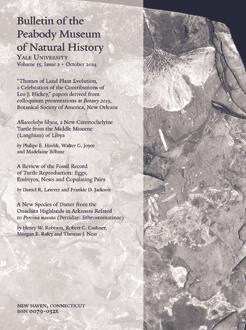In their 1977 study on Potomac Group angiosperms, Hickey and Doyle made only broad comparisons with living taxa. Newer data, especially discoveries of fossil flowers in the Potomac and coeval deposits and increasingly robust molecular phylogenies of living angiosperms, allow more precise phylogenetic placement of fossils. Hickey and Doyle compared most early Potomac leaves (Aptian—early Albian) with “magnoliids,” a paraphyletic group as then defined, but several clades can now be recognized. Leaves and dispersed cuticles share epidermal features with woody members of the basal ANITA grade, and in some cases crown group Austrobaileyales, whose presence is confirmed by flowers called Anacostia. Aptian—Albian flowers (Monetianthus, Carpestella) and whole plants (Pluricarpellatia) are nested in crown group Nymphaeales; Potomac reniform leaves could belong to this clade. Several Potomac leaves have chloranthoid teeth, venation, and opposite phyllotaxis consistent with Chloranthaceae, while Aptian to Cenomanian flowers reveal the presence of both crown group Chloranthaceae (Asteropollis plant, near Hedyosmum) and stem relatives of this family and/or Ceratophyllum (Canrightia, Zlatkocarpus, Pennipollis plant, possibly Appomattoxia). Phylogenetic analyses confirm interpretations of Aptian Liliacidites pollen and Acaciaephyllum as monocots. Ternately lobed leaves such as Vitiphyllum may represent basal eudicots, in or below Ranunculales. In the late Potomac (middle to late Albian), the rise of tricolpate pollen and local dominance of angiosperm leaves mark the influx of near-basal eudicot clades. Associated floral receptacles confirm that Nelumbites leaves were related to Nelumbo (Proteales), while heads of unisexual flowers indicate that both palmately lobed “platanoid” and pinnatifid Sapindopsis leaves (previously compared with rosids) were stem relatives of Platanus (also Proteales). Flowers called Spanomera are related to Buxaceae. Several Albian and early Cenomanian flowers belong to Magnoliidae in the new monophyletic sense, including Archaeanthus in Magnoliales and Virginianthus and Mauldinia in Laurales; Laurales are common in the late Albian leaf record.
How to translate text using browser tools
1 October 2014
Angiosperm Clades in the Potomac Group: What Have We Learned since 1977?
James A. Doyle,
Garland R. Upchurch
ACCESS THE FULL ARTICLE
Austrobaileyales
Chloranthaceae
Cretaceous
eudicots
Laurales
monocots
Nymphaeales





